Exploring Ethical and Legal Issues in Nursing: A Scenario-Based Report
VerifiedAdded on 2023/01/12
|9
|2640
|94
Report
AI Summary
This report provides a detailed analysis of a nursing scenario involving a registered nurse, Michelle, and her patient, James Keren. The report identifies several ethical and legal issues, including Michelle's denial of assistance to the patient, her failure to check the patient's fluid balance, and the administration of PRN analgesia despite the patient's denial of pain. The report discusses relevant codes of ethics, codes of conduct, and registered nurse standards, highlighting the importance of non-maleficence, beneficence, patient confidentiality, and professional responsibility. It examines the legal implications of negligence and medication errors, emphasizing the need for nurses to adhere to ethical guidelines and provide patient-centered care. The report concludes by summarizing the key findings and reiterating the importance of ethical practice within the healthcare setting to ensure positive patient outcomes and uphold professional standards. This document is available on Desklib, a platform offering AI-powered study tools and resources for students.
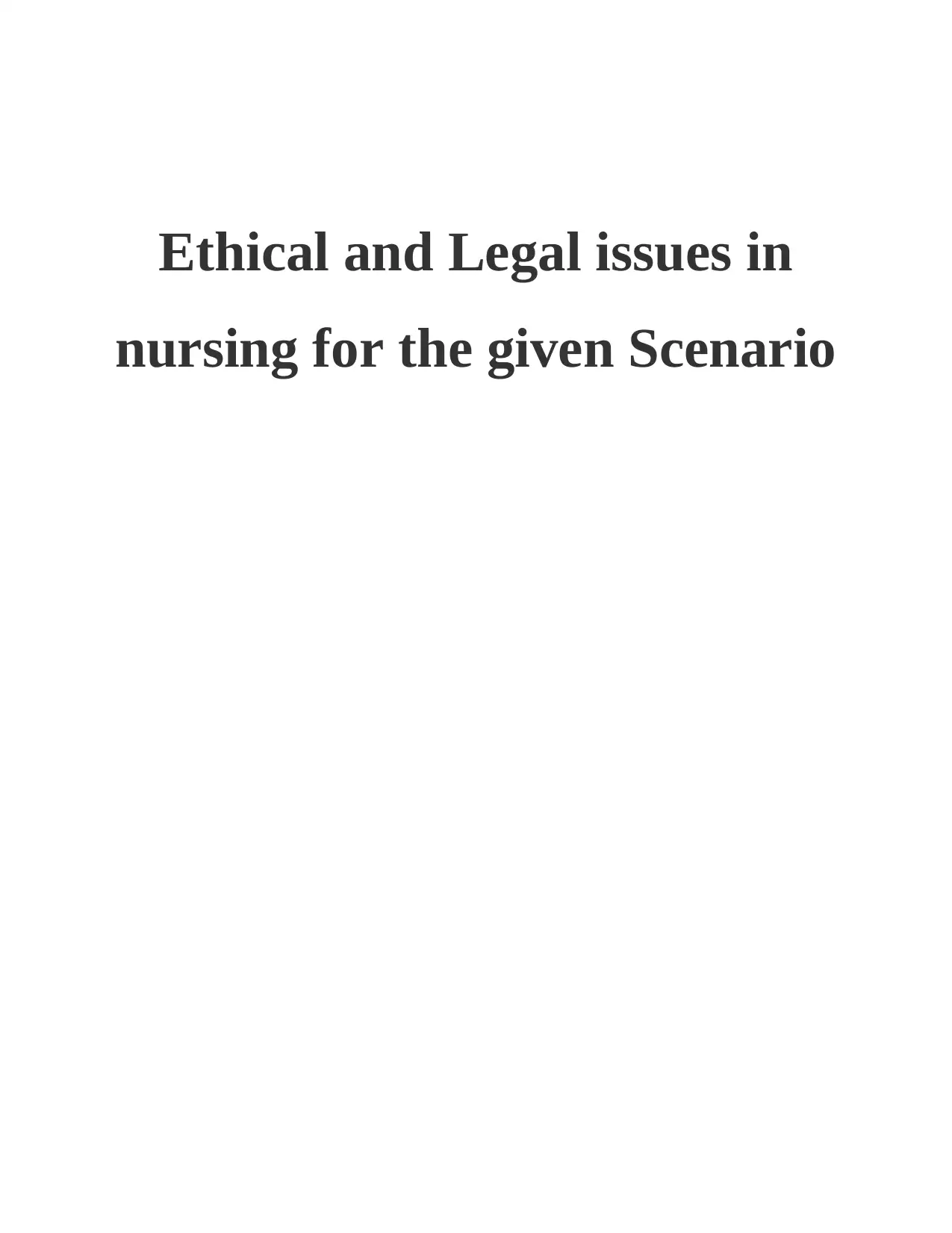
Ethical and Legal issues in
nursing for the given Scenario
nursing for the given Scenario
Paraphrase This Document
Need a fresh take? Get an instant paraphrase of this document with our AI Paraphraser
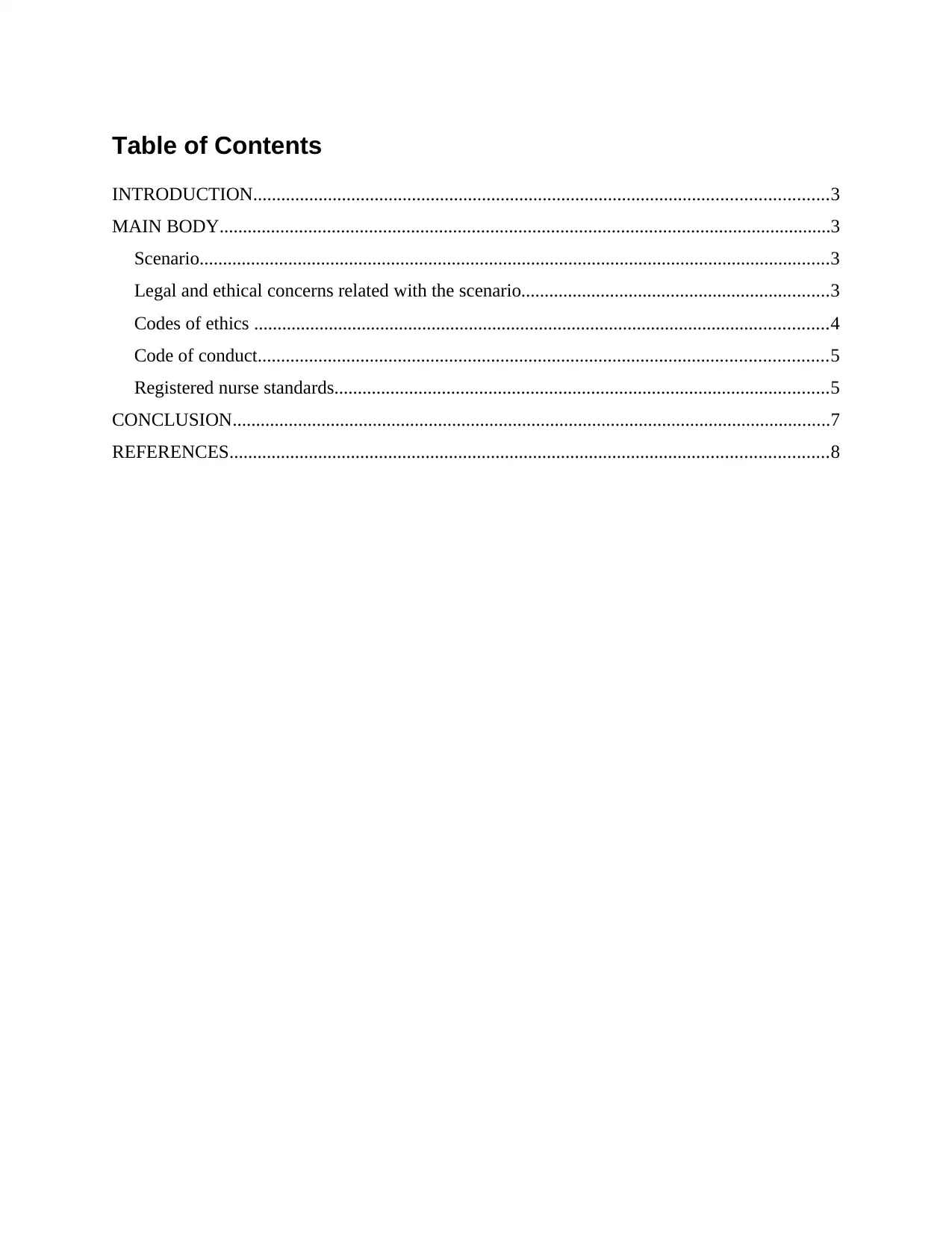
Table of Contents
INTRODUCTION...........................................................................................................................3
MAIN BODY...................................................................................................................................3
Scenario.......................................................................................................................................3
Legal and ethical concerns related with the scenario..................................................................3
Codes of ethics ...........................................................................................................................4
Code of conduct..........................................................................................................................5
Registered nurse standards..........................................................................................................5
CONCLUSION................................................................................................................................7
REFERENCES................................................................................................................................8
INTRODUCTION...........................................................................................................................3
MAIN BODY...................................................................................................................................3
Scenario.......................................................................................................................................3
Legal and ethical concerns related with the scenario..................................................................3
Codes of ethics ...........................................................................................................................4
Code of conduct..........................................................................................................................5
Registered nurse standards..........................................................................................................5
CONCLUSION................................................................................................................................7
REFERENCES................................................................................................................................8
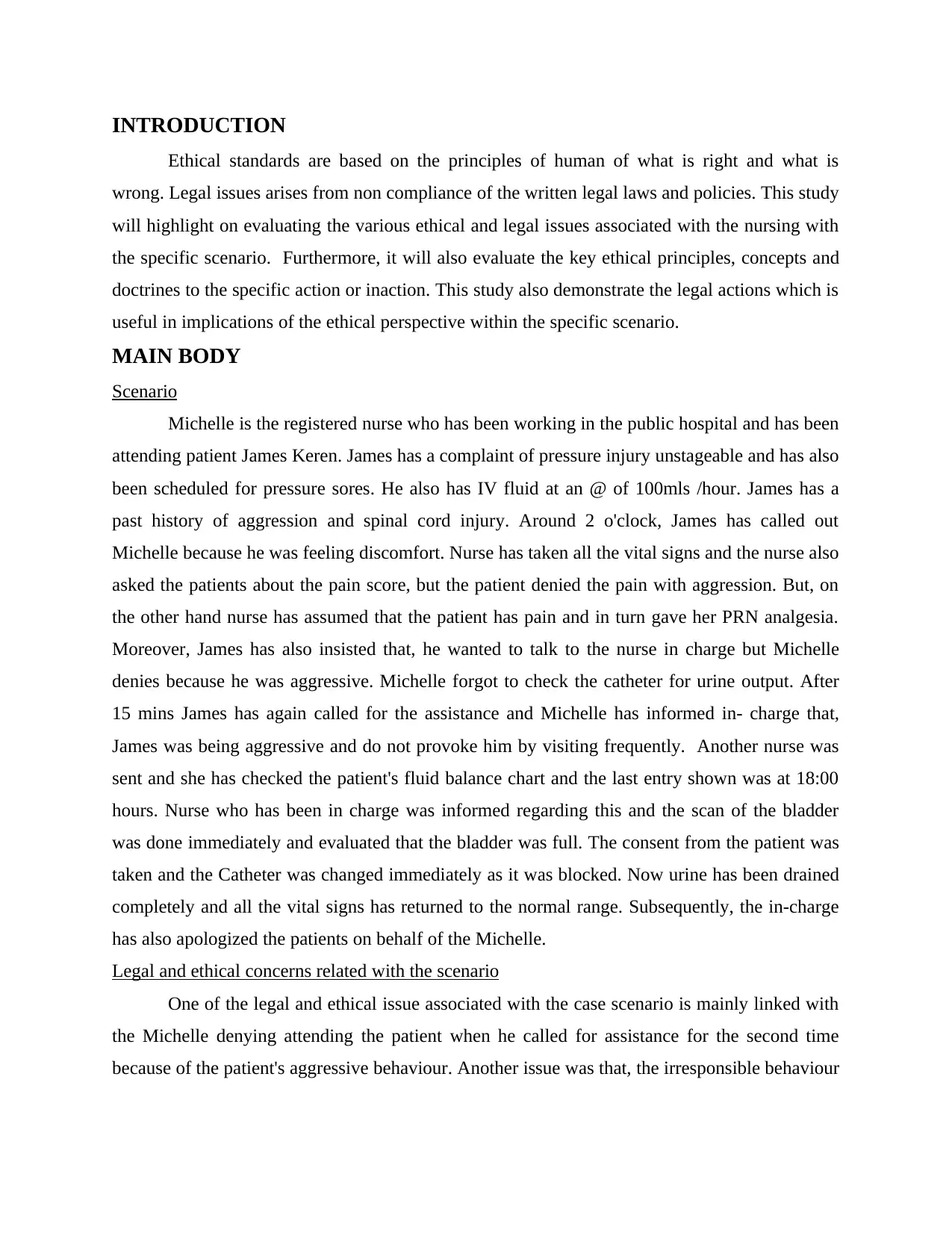
INTRODUCTION
Ethical standards are based on the principles of human of what is right and what is
wrong. Legal issues arises from non compliance of the written legal laws and policies. This study
will highlight on evaluating the various ethical and legal issues associated with the nursing with
the specific scenario. Furthermore, it will also evaluate the key ethical principles, concepts and
doctrines to the specific action or inaction. This study also demonstrate the legal actions which is
useful in implications of the ethical perspective within the specific scenario.
MAIN BODY
Scenario
Michelle is the registered nurse who has been working in the public hospital and has been
attending patient James Keren. James has a complaint of pressure injury unstageable and has also
been scheduled for pressure sores. He also has IV fluid at an @ of 100mls /hour. James has a
past history of aggression and spinal cord injury. Around 2 o'clock, James has called out
Michelle because he was feeling discomfort. Nurse has taken all the vital signs and the nurse also
asked the patients about the pain score, but the patient denied the pain with aggression. But, on
the other hand nurse has assumed that the patient has pain and in turn gave her PRN analgesia.
Moreover, James has also insisted that, he wanted to talk to the nurse in charge but Michelle
denies because he was aggressive. Michelle forgot to check the catheter for urine output. After
15 mins James has again called for the assistance and Michelle has informed in- charge that,
James was being aggressive and do not provoke him by visiting frequently. Another nurse was
sent and she has checked the patient's fluid balance chart and the last entry shown was at 18:00
hours. Nurse who has been in charge was informed regarding this and the scan of the bladder
was done immediately and evaluated that the bladder was full. The consent from the patient was
taken and the Catheter was changed immediately as it was blocked. Now urine has been drained
completely and all the vital signs has returned to the normal range. Subsequently, the in-charge
has also apologized the patients on behalf of the Michelle.
Legal and ethical concerns related with the scenario
One of the legal and ethical issue associated with the case scenario is mainly linked with
the Michelle denying attending the patient when he called for assistance for the second time
because of the patient's aggressive behaviour. Another issue was that, the irresponsible behaviour
Ethical standards are based on the principles of human of what is right and what is
wrong. Legal issues arises from non compliance of the written legal laws and policies. This study
will highlight on evaluating the various ethical and legal issues associated with the nursing with
the specific scenario. Furthermore, it will also evaluate the key ethical principles, concepts and
doctrines to the specific action or inaction. This study also demonstrate the legal actions which is
useful in implications of the ethical perspective within the specific scenario.
MAIN BODY
Scenario
Michelle is the registered nurse who has been working in the public hospital and has been
attending patient James Keren. James has a complaint of pressure injury unstageable and has also
been scheduled for pressure sores. He also has IV fluid at an @ of 100mls /hour. James has a
past history of aggression and spinal cord injury. Around 2 o'clock, James has called out
Michelle because he was feeling discomfort. Nurse has taken all the vital signs and the nurse also
asked the patients about the pain score, but the patient denied the pain with aggression. But, on
the other hand nurse has assumed that the patient has pain and in turn gave her PRN analgesia.
Moreover, James has also insisted that, he wanted to talk to the nurse in charge but Michelle
denies because he was aggressive. Michelle forgot to check the catheter for urine output. After
15 mins James has again called for the assistance and Michelle has informed in- charge that,
James was being aggressive and do not provoke him by visiting frequently. Another nurse was
sent and she has checked the patient's fluid balance chart and the last entry shown was at 18:00
hours. Nurse who has been in charge was informed regarding this and the scan of the bladder
was done immediately and evaluated that the bladder was full. The consent from the patient was
taken and the Catheter was changed immediately as it was blocked. Now urine has been drained
completely and all the vital signs has returned to the normal range. Subsequently, the in-charge
has also apologized the patients on behalf of the Michelle.
Legal and ethical concerns related with the scenario
One of the legal and ethical issue associated with the case scenario is mainly linked with
the Michelle denying attending the patient when he called for assistance for the second time
because of the patient's aggressive behaviour. Another issue was that, the irresponsible behaviour
⊘ This is a preview!⊘
Do you want full access?
Subscribe today to unlock all pages.

Trusted by 1+ million students worldwide
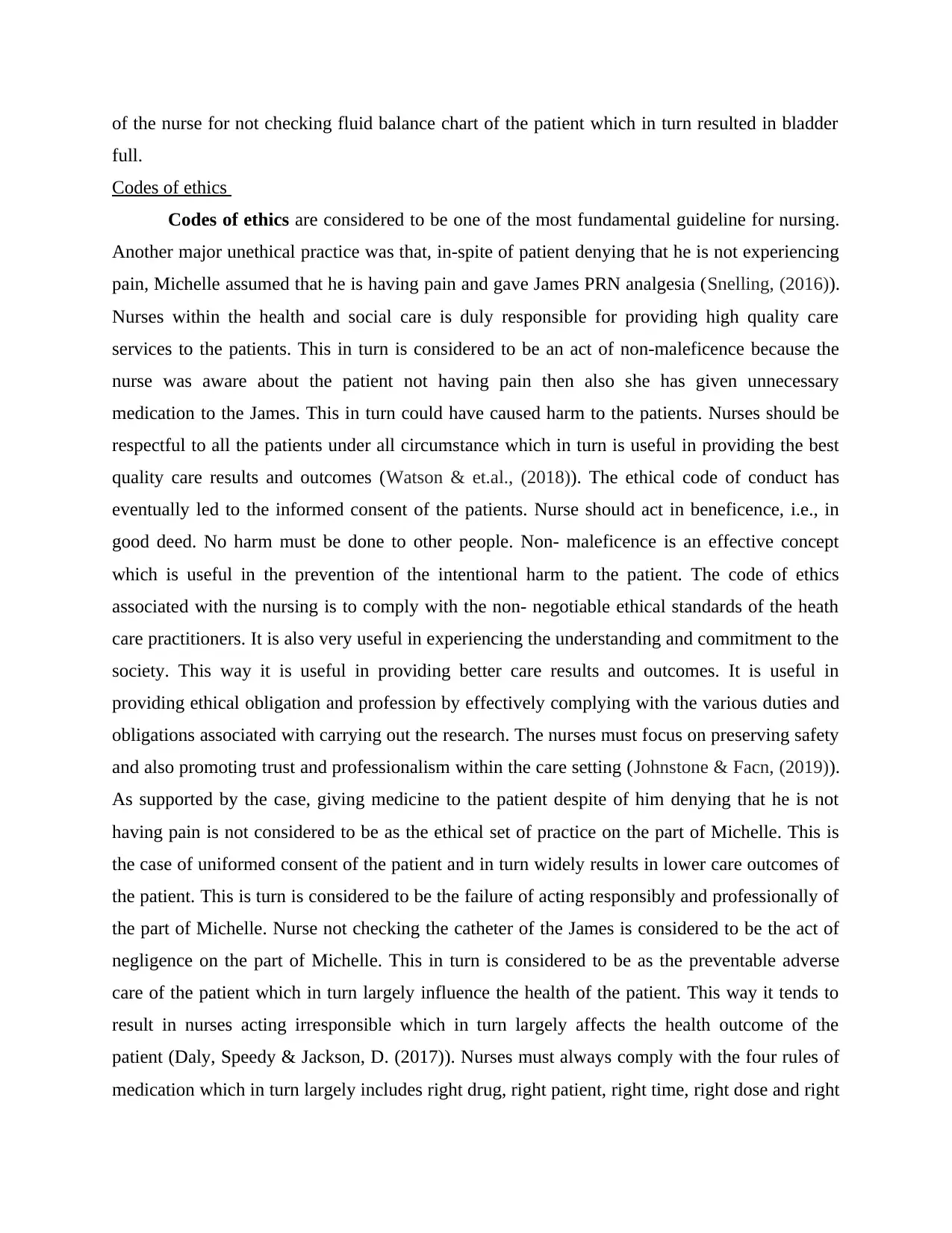
of the nurse for not checking fluid balance chart of the patient which in turn resulted in bladder
full.
Codes of ethics
Codes of ethics are considered to be one of the most fundamental guideline for nursing.
Another major unethical practice was that, in-spite of patient denying that he is not experiencing
pain, Michelle assumed that he is having pain and gave James PRN analgesia (Snelling, (2016)).
Nurses within the health and social care is duly responsible for providing high quality care
services to the patients. This in turn is considered to be an act of non-maleficence because the
nurse was aware about the patient not having pain then also she has given unnecessary
medication to the James. This in turn could have caused harm to the patients. Nurses should be
respectful to all the patients under all circumstance which in turn is useful in providing the best
quality care results and outcomes (Watson & et.al., (2018)). The ethical code of conduct has
eventually led to the informed consent of the patients. Nurse should act in beneficence, i.e., in
good deed. No harm must be done to other people. Non- maleficence is an effective concept
which is useful in the prevention of the intentional harm to the patient. The code of ethics
associated with the nursing is to comply with the non- negotiable ethical standards of the heath
care practitioners. It is also very useful in experiencing the understanding and commitment to the
society. This way it is useful in providing better care results and outcomes. It is useful in
providing ethical obligation and profession by effectively complying with the various duties and
obligations associated with carrying out the research. The nurses must focus on preserving safety
and also promoting trust and professionalism within the care setting (Johnstone & Facn, (2019)).
As supported by the case, giving medicine to the patient despite of him denying that he is not
having pain is not considered to be as the ethical set of practice on the part of Michelle. This is
the case of uniformed consent of the patient and in turn widely results in lower care outcomes of
the patient. This is turn is considered to be the failure of acting responsibly and professionally of
the part of Michelle. Nurse not checking the catheter of the James is considered to be the act of
negligence on the part of Michelle. This in turn is considered to be as the preventable adverse
care of the patient which in turn largely influence the health of the patient. This way it tends to
result in nurses acting irresponsible which in turn largely affects the health outcome of the
patient (Daly, Speedy & Jackson, D. (2017)). Nurses must always comply with the four rules of
medication which in turn largely includes right drug, right patient, right time, right dose and right
full.
Codes of ethics
Codes of ethics are considered to be one of the most fundamental guideline for nursing.
Another major unethical practice was that, in-spite of patient denying that he is not experiencing
pain, Michelle assumed that he is having pain and gave James PRN analgesia (Snelling, (2016)).
Nurses within the health and social care is duly responsible for providing high quality care
services to the patients. This in turn is considered to be an act of non-maleficence because the
nurse was aware about the patient not having pain then also she has given unnecessary
medication to the James. This in turn could have caused harm to the patients. Nurses should be
respectful to all the patients under all circumstance which in turn is useful in providing the best
quality care results and outcomes (Watson & et.al., (2018)). The ethical code of conduct has
eventually led to the informed consent of the patients. Nurse should act in beneficence, i.e., in
good deed. No harm must be done to other people. Non- maleficence is an effective concept
which is useful in the prevention of the intentional harm to the patient. The code of ethics
associated with the nursing is to comply with the non- negotiable ethical standards of the heath
care practitioners. It is also very useful in experiencing the understanding and commitment to the
society. This way it is useful in providing better care results and outcomes. It is useful in
providing ethical obligation and profession by effectively complying with the various duties and
obligations associated with carrying out the research. The nurses must focus on preserving safety
and also promoting trust and professionalism within the care setting (Johnstone & Facn, (2019)).
As supported by the case, giving medicine to the patient despite of him denying that he is not
having pain is not considered to be as the ethical set of practice on the part of Michelle. This is
the case of uniformed consent of the patient and in turn widely results in lower care outcomes of
the patient. This is turn is considered to be the failure of acting responsibly and professionally of
the part of Michelle. Nurse not checking the catheter of the James is considered to be the act of
negligence on the part of Michelle. This in turn is considered to be as the preventable adverse
care of the patient which in turn largely influence the health of the patient. This way it tends to
result in nurses acting irresponsible which in turn largely affects the health outcome of the
patient (Daly, Speedy & Jackson, D. (2017)). Nurses must always comply with the four rules of
medication which in turn largely includes right drug, right patient, right time, right dose and right
Paraphrase This Document
Need a fresh take? Get an instant paraphrase of this document with our AI Paraphraser
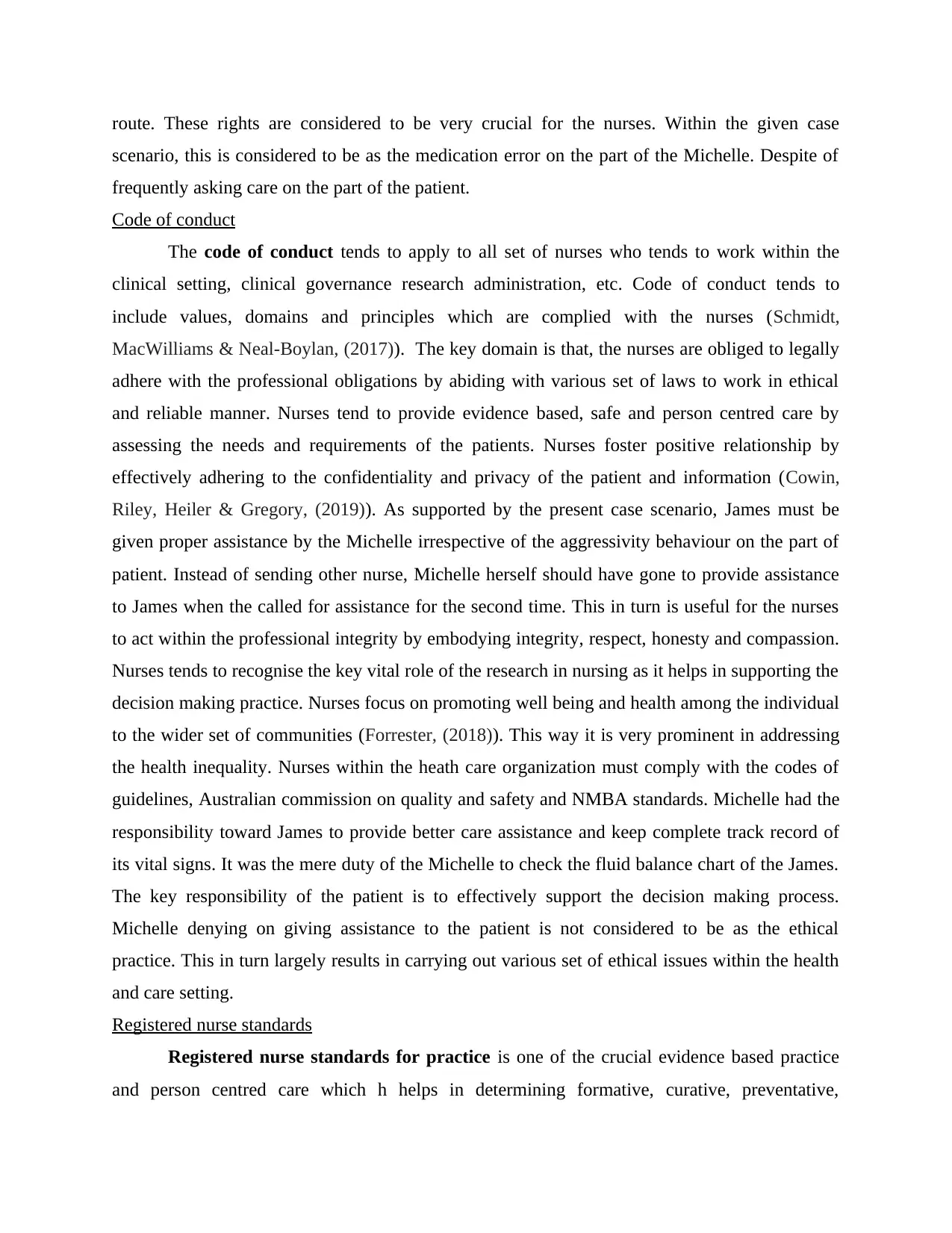
route. These rights are considered to be very crucial for the nurses. Within the given case
scenario, this is considered to be as the medication error on the part of the Michelle. Despite of
frequently asking care on the part of the patient.
Code of conduct
The code of conduct tends to apply to all set of nurses who tends to work within the
clinical setting, clinical governance research administration, etc. Code of conduct tends to
include values, domains and principles which are complied with the nurses (Schmidt,
MacWilliams & Neal-Boylan, (2017)). The key domain is that, the nurses are obliged to legally
adhere with the professional obligations by abiding with various set of laws to work in ethical
and reliable manner. Nurses tend to provide evidence based, safe and person centred care by
assessing the needs and requirements of the patients. Nurses foster positive relationship by
effectively adhering to the confidentiality and privacy of the patient and information (Cowin,
Riley, Heiler & Gregory, (2019)). As supported by the present case scenario, James must be
given proper assistance by the Michelle irrespective of the aggressivity behaviour on the part of
patient. Instead of sending other nurse, Michelle herself should have gone to provide assistance
to James when the called for assistance for the second time. This in turn is useful for the nurses
to act within the professional integrity by embodying integrity, respect, honesty and compassion.
Nurses tends to recognise the key vital role of the research in nursing as it helps in supporting the
decision making practice. Nurses focus on promoting well being and health among the individual
to the wider set of communities (Forrester, (2018)). This way it is very prominent in addressing
the health inequality. Nurses within the heath care organization must comply with the codes of
guidelines, Australian commission on quality and safety and NMBA standards. Michelle had the
responsibility toward James to provide better care assistance and keep complete track record of
its vital signs. It was the mere duty of the Michelle to check the fluid balance chart of the James.
The key responsibility of the patient is to effectively support the decision making process.
Michelle denying on giving assistance to the patient is not considered to be as the ethical
practice. This in turn largely results in carrying out various set of ethical issues within the health
and care setting.
Registered nurse standards
Registered nurse standards for practice is one of the crucial evidence based practice
and person centred care which h helps in determining formative, curative, preventative,
scenario, this is considered to be as the medication error on the part of the Michelle. Despite of
frequently asking care on the part of the patient.
Code of conduct
The code of conduct tends to apply to all set of nurses who tends to work within the
clinical setting, clinical governance research administration, etc. Code of conduct tends to
include values, domains and principles which are complied with the nurses (Schmidt,
MacWilliams & Neal-Boylan, (2017)). The key domain is that, the nurses are obliged to legally
adhere with the professional obligations by abiding with various set of laws to work in ethical
and reliable manner. Nurses tend to provide evidence based, safe and person centred care by
assessing the needs and requirements of the patients. Nurses foster positive relationship by
effectively adhering to the confidentiality and privacy of the patient and information (Cowin,
Riley, Heiler & Gregory, (2019)). As supported by the present case scenario, James must be
given proper assistance by the Michelle irrespective of the aggressivity behaviour on the part of
patient. Instead of sending other nurse, Michelle herself should have gone to provide assistance
to James when the called for assistance for the second time. This in turn is useful for the nurses
to act within the professional integrity by embodying integrity, respect, honesty and compassion.
Nurses tends to recognise the key vital role of the research in nursing as it helps in supporting the
decision making practice. Nurses focus on promoting well being and health among the individual
to the wider set of communities (Forrester, (2018)). This way it is very prominent in addressing
the health inequality. Nurses within the heath care organization must comply with the codes of
guidelines, Australian commission on quality and safety and NMBA standards. Michelle had the
responsibility toward James to provide better care assistance and keep complete track record of
its vital signs. It was the mere duty of the Michelle to check the fluid balance chart of the James.
The key responsibility of the patient is to effectively support the decision making process.
Michelle denying on giving assistance to the patient is not considered to be as the ethical
practice. This in turn largely results in carrying out various set of ethical issues within the health
and care setting.
Registered nurse standards
Registered nurse standards for practice is one of the crucial evidence based practice
and person centred care which h helps in determining formative, curative, preventative,
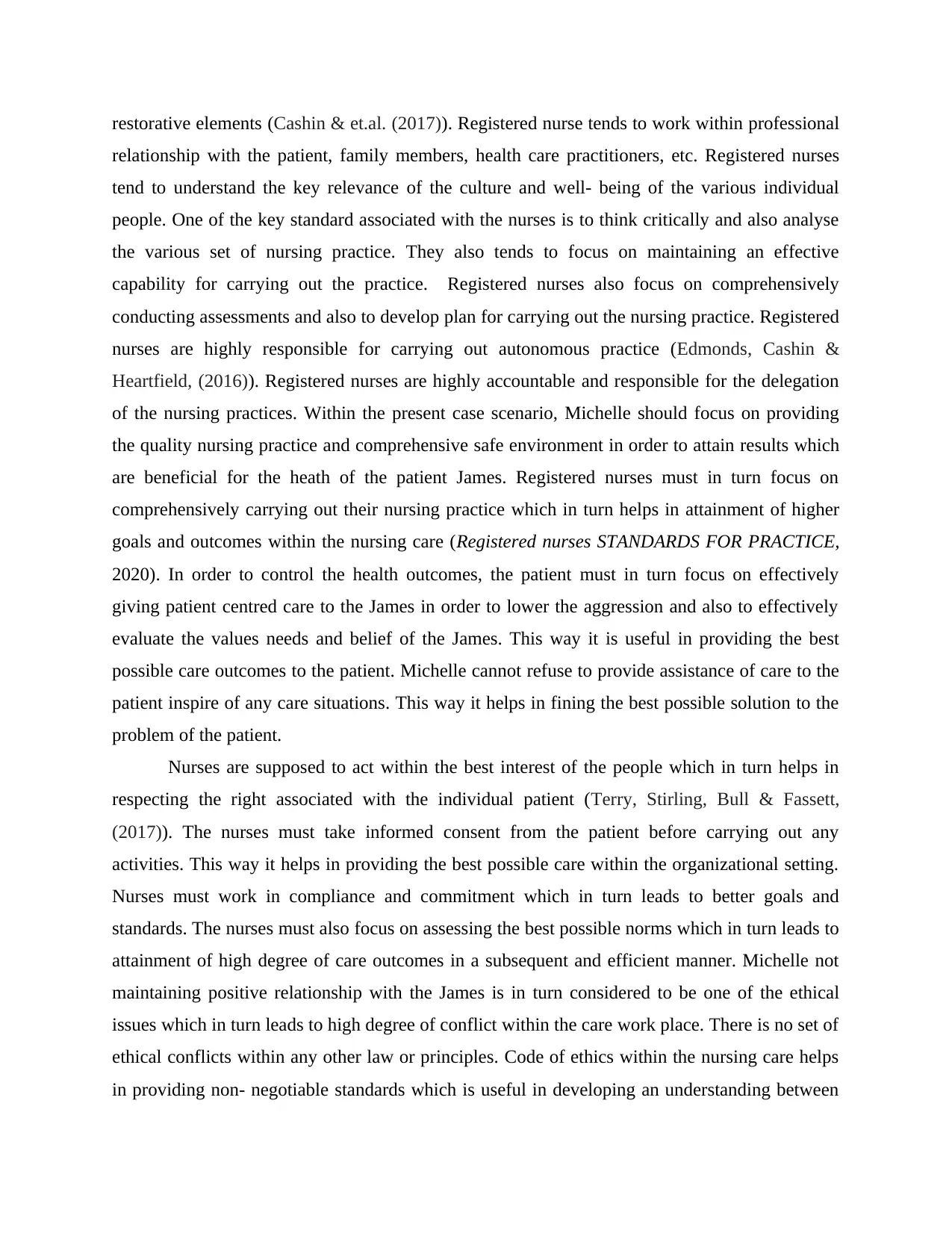
restorative elements (Cashin & et.al. (2017)). Registered nurse tends to work within professional
relationship with the patient, family members, health care practitioners, etc. Registered nurses
tend to understand the key relevance of the culture and well- being of the various individual
people. One of the key standard associated with the nurses is to think critically and also analyse
the various set of nursing practice. They also tends to focus on maintaining an effective
capability for carrying out the practice. Registered nurses also focus on comprehensively
conducting assessments and also to develop plan for carrying out the nursing practice. Registered
nurses are highly responsible for carrying out autonomous practice (Edmonds, Cashin &
Heartfield, (2016)). Registered nurses are highly accountable and responsible for the delegation
of the nursing practices. Within the present case scenario, Michelle should focus on providing
the quality nursing practice and comprehensive safe environment in order to attain results which
are beneficial for the heath of the patient James. Registered nurses must in turn focus on
comprehensively carrying out their nursing practice which in turn helps in attainment of higher
goals and outcomes within the nursing care (Registered nurses STANDARDS FOR PRACTICE,
2020). In order to control the health outcomes, the patient must in turn focus on effectively
giving patient centred care to the James in order to lower the aggression and also to effectively
evaluate the values needs and belief of the James. This way it is useful in providing the best
possible care outcomes to the patient. Michelle cannot refuse to provide assistance of care to the
patient inspire of any care situations. This way it helps in fining the best possible solution to the
problem of the patient.
Nurses are supposed to act within the best interest of the people which in turn helps in
respecting the right associated with the individual patient (Terry, Stirling, Bull & Fassett,
(2017)). The nurses must take informed consent from the patient before carrying out any
activities. This way it helps in providing the best possible care within the organizational setting.
Nurses must work in compliance and commitment which in turn leads to better goals and
standards. The nurses must also focus on assessing the best possible norms which in turn leads to
attainment of high degree of care outcomes in a subsequent and efficient manner. Michelle not
maintaining positive relationship with the James is in turn considered to be one of the ethical
issues which in turn leads to high degree of conflict within the care work place. There is no set of
ethical conflicts within any other law or principles. Code of ethics within the nursing care helps
in providing non- negotiable standards which is useful in developing an understanding between
relationship with the patient, family members, health care practitioners, etc. Registered nurses
tend to understand the key relevance of the culture and well- being of the various individual
people. One of the key standard associated with the nurses is to think critically and also analyse
the various set of nursing practice. They also tends to focus on maintaining an effective
capability for carrying out the practice. Registered nurses also focus on comprehensively
conducting assessments and also to develop plan for carrying out the nursing practice. Registered
nurses are highly responsible for carrying out autonomous practice (Edmonds, Cashin &
Heartfield, (2016)). Registered nurses are highly accountable and responsible for the delegation
of the nursing practices. Within the present case scenario, Michelle should focus on providing
the quality nursing practice and comprehensive safe environment in order to attain results which
are beneficial for the heath of the patient James. Registered nurses must in turn focus on
comprehensively carrying out their nursing practice which in turn helps in attainment of higher
goals and outcomes within the nursing care (Registered nurses STANDARDS FOR PRACTICE,
2020). In order to control the health outcomes, the patient must in turn focus on effectively
giving patient centred care to the James in order to lower the aggression and also to effectively
evaluate the values needs and belief of the James. This way it is useful in providing the best
possible care outcomes to the patient. Michelle cannot refuse to provide assistance of care to the
patient inspire of any care situations. This way it helps in fining the best possible solution to the
problem of the patient.
Nurses are supposed to act within the best interest of the people which in turn helps in
respecting the right associated with the individual patient (Terry, Stirling, Bull & Fassett,
(2017)). The nurses must take informed consent from the patient before carrying out any
activities. This way it helps in providing the best possible care within the organizational setting.
Nurses must work in compliance and commitment which in turn leads to better goals and
standards. The nurses must also focus on assessing the best possible norms which in turn leads to
attainment of high degree of care outcomes in a subsequent and efficient manner. Michelle not
maintaining positive relationship with the James is in turn considered to be one of the ethical
issues which in turn leads to high degree of conflict within the care work place. There is no set of
ethical conflicts within any other law or principles. Code of ethics within the nursing care helps
in providing non- negotiable standards which is useful in developing an understanding between
⊘ This is a preview!⊘
Do you want full access?
Subscribe today to unlock all pages.

Trusted by 1+ million students worldwide
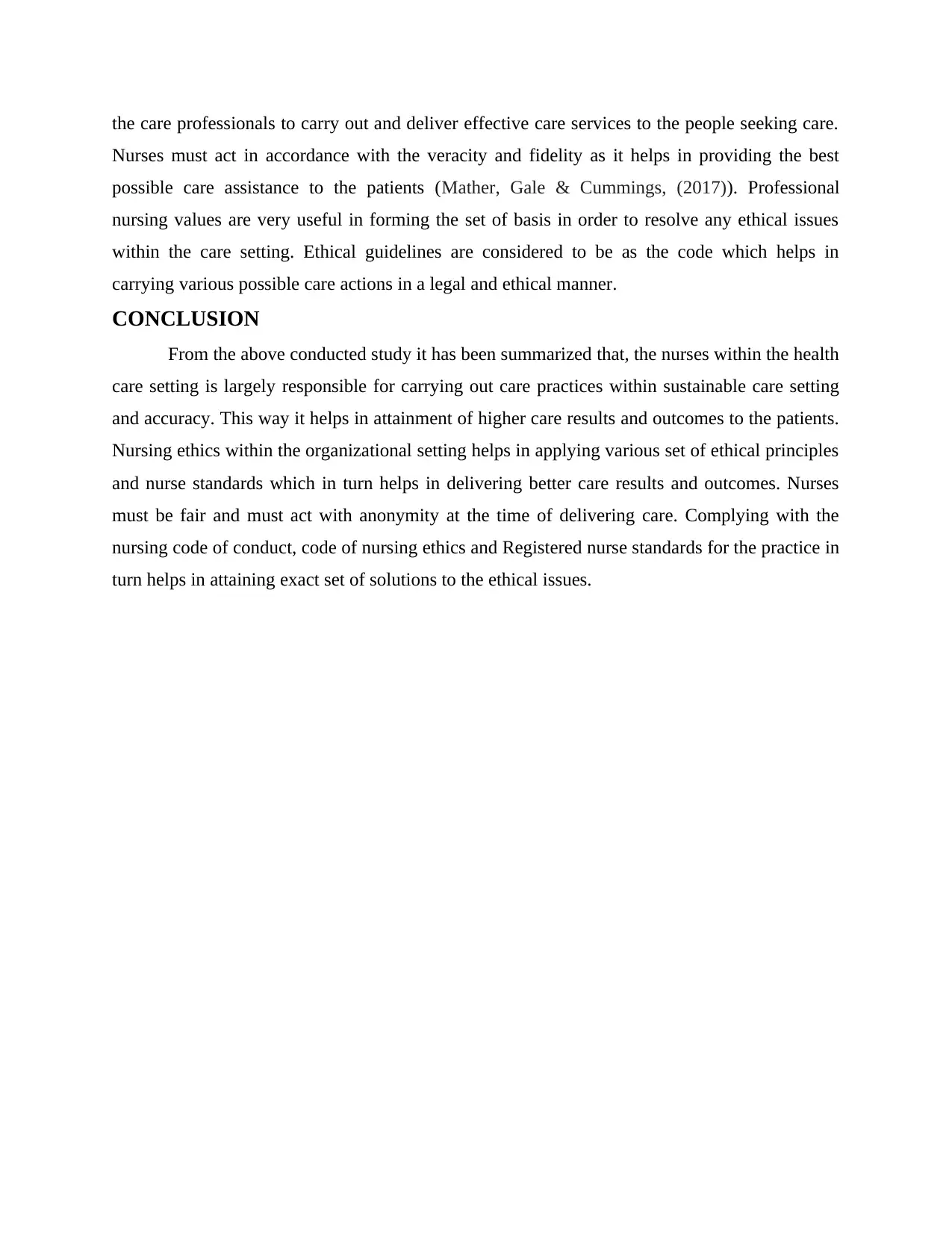
the care professionals to carry out and deliver effective care services to the people seeking care.
Nurses must act in accordance with the veracity and fidelity as it helps in providing the best
possible care assistance to the patients (Mather, Gale & Cummings, (2017)). Professional
nursing values are very useful in forming the set of basis in order to resolve any ethical issues
within the care setting. Ethical guidelines are considered to be as the code which helps in
carrying various possible care actions in a legal and ethical manner.
CONCLUSION
From the above conducted study it has been summarized that, the nurses within the health
care setting is largely responsible for carrying out care practices within sustainable care setting
and accuracy. This way it helps in attainment of higher care results and outcomes to the patients.
Nursing ethics within the organizational setting helps in applying various set of ethical principles
and nurse standards which in turn helps in delivering better care results and outcomes. Nurses
must be fair and must act with anonymity at the time of delivering care. Complying with the
nursing code of conduct, code of nursing ethics and Registered nurse standards for the practice in
turn helps in attaining exact set of solutions to the ethical issues.
Nurses must act in accordance with the veracity and fidelity as it helps in providing the best
possible care assistance to the patients (Mather, Gale & Cummings, (2017)). Professional
nursing values are very useful in forming the set of basis in order to resolve any ethical issues
within the care setting. Ethical guidelines are considered to be as the code which helps in
carrying various possible care actions in a legal and ethical manner.
CONCLUSION
From the above conducted study it has been summarized that, the nurses within the health
care setting is largely responsible for carrying out care practices within sustainable care setting
and accuracy. This way it helps in attainment of higher care results and outcomes to the patients.
Nursing ethics within the organizational setting helps in applying various set of ethical principles
and nurse standards which in turn helps in delivering better care results and outcomes. Nurses
must be fair and must act with anonymity at the time of delivering care. Complying with the
nursing code of conduct, code of nursing ethics and Registered nurse standards for the practice in
turn helps in attaining exact set of solutions to the ethical issues.
Paraphrase This Document
Need a fresh take? Get an instant paraphrase of this document with our AI Paraphraser
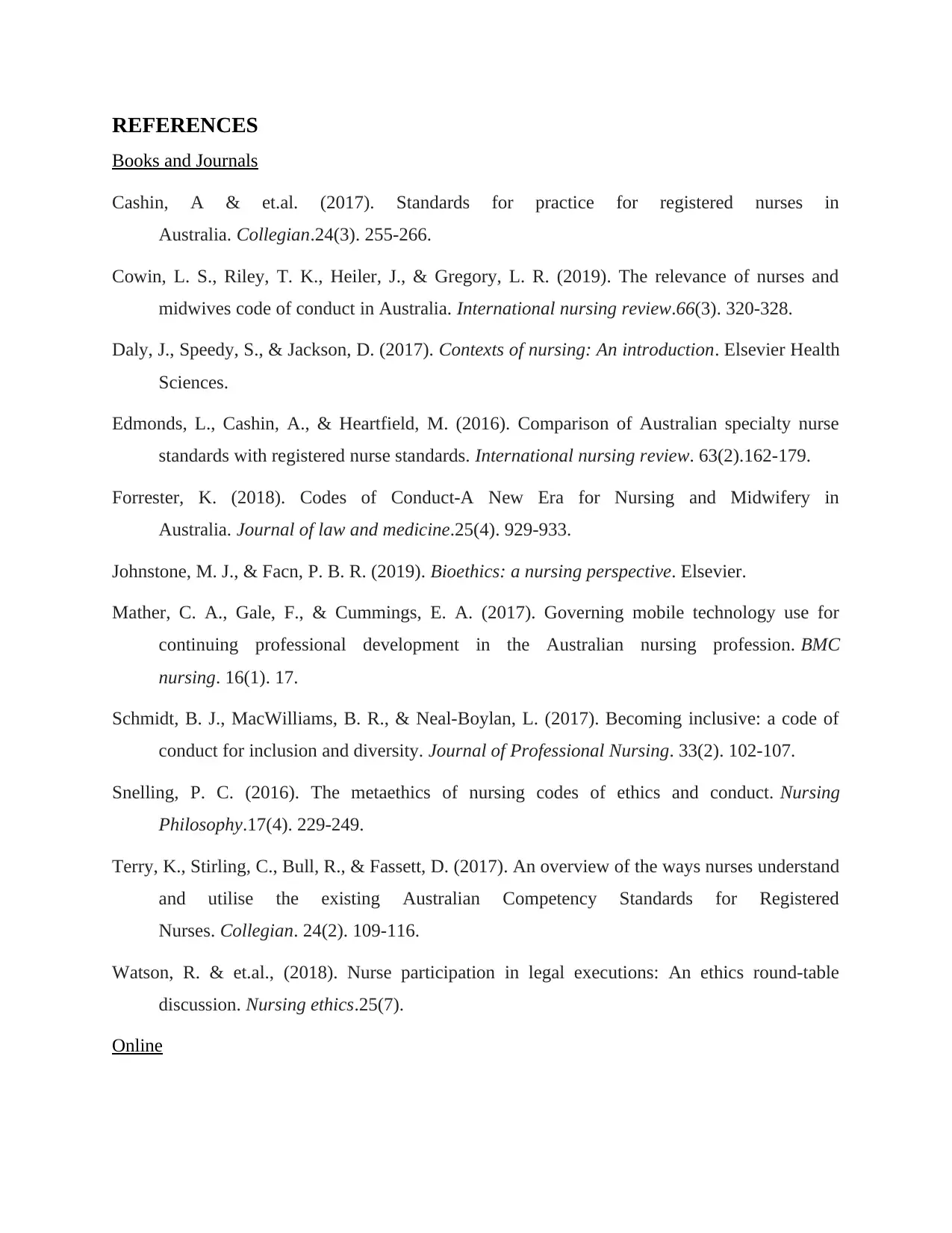
REFERENCES
Books and Journals
Cashin, A & et.al. (2017). Standards for practice for registered nurses in
Australia. Collegian.24(3). 255-266.
Cowin, L. S., Riley, T. K., Heiler, J., & Gregory, L. R. (2019). The relevance of nurses and
midwives code of conduct in Australia. International nursing review.66(3). 320-328.
Daly, J., Speedy, S., & Jackson, D. (2017). Contexts of nursing: An introduction. Elsevier Health
Sciences.
Edmonds, L., Cashin, A., & Heartfield, M. (2016). Comparison of Australian specialty nurse
standards with registered nurse standards. International nursing review. 63(2).162-179.
Forrester, K. (2018). Codes of Conduct-A New Era for Nursing and Midwifery in
Australia. Journal of law and medicine.25(4). 929-933.
Johnstone, M. J., & Facn, P. B. R. (2019). Bioethics: a nursing perspective. Elsevier.
Mather, C. A., Gale, F., & Cummings, E. A. (2017). Governing mobile technology use for
continuing professional development in the Australian nursing profession. BMC
nursing. 16(1). 17.
Schmidt, B. J., MacWilliams, B. R., & Neal-Boylan, L. (2017). Becoming inclusive: a code of
conduct for inclusion and diversity. Journal of Professional Nursing. 33(2). 102-107.
Snelling, P. C. (2016). The metaethics of nursing codes of ethics and conduct. Nursing
Philosophy.17(4). 229-249.
Terry, K., Stirling, C., Bull, R., & Fassett, D. (2017). An overview of the ways nurses understand
and utilise the existing Australian Competency Standards for Registered
Nurses. Collegian. 24(2). 109-116.
Watson, R. & et.al., (2018). Nurse participation in legal executions: An ethics round-table
discussion. Nursing ethics.25(7).
Online
Books and Journals
Cashin, A & et.al. (2017). Standards for practice for registered nurses in
Australia. Collegian.24(3). 255-266.
Cowin, L. S., Riley, T. K., Heiler, J., & Gregory, L. R. (2019). The relevance of nurses and
midwives code of conduct in Australia. International nursing review.66(3). 320-328.
Daly, J., Speedy, S., & Jackson, D. (2017). Contexts of nursing: An introduction. Elsevier Health
Sciences.
Edmonds, L., Cashin, A., & Heartfield, M. (2016). Comparison of Australian specialty nurse
standards with registered nurse standards. International nursing review. 63(2).162-179.
Forrester, K. (2018). Codes of Conduct-A New Era for Nursing and Midwifery in
Australia. Journal of law and medicine.25(4). 929-933.
Johnstone, M. J., & Facn, P. B. R. (2019). Bioethics: a nursing perspective. Elsevier.
Mather, C. A., Gale, F., & Cummings, E. A. (2017). Governing mobile technology use for
continuing professional development in the Australian nursing profession. BMC
nursing. 16(1). 17.
Schmidt, B. J., MacWilliams, B. R., & Neal-Boylan, L. (2017). Becoming inclusive: a code of
conduct for inclusion and diversity. Journal of Professional Nursing. 33(2). 102-107.
Snelling, P. C. (2016). The metaethics of nursing codes of ethics and conduct. Nursing
Philosophy.17(4). 229-249.
Terry, K., Stirling, C., Bull, R., & Fassett, D. (2017). An overview of the ways nurses understand
and utilise the existing Australian Competency Standards for Registered
Nurses. Collegian. 24(2). 109-116.
Watson, R. & et.al., (2018). Nurse participation in legal executions: An ethics round-table
discussion. Nursing ethics.25(7).
Online
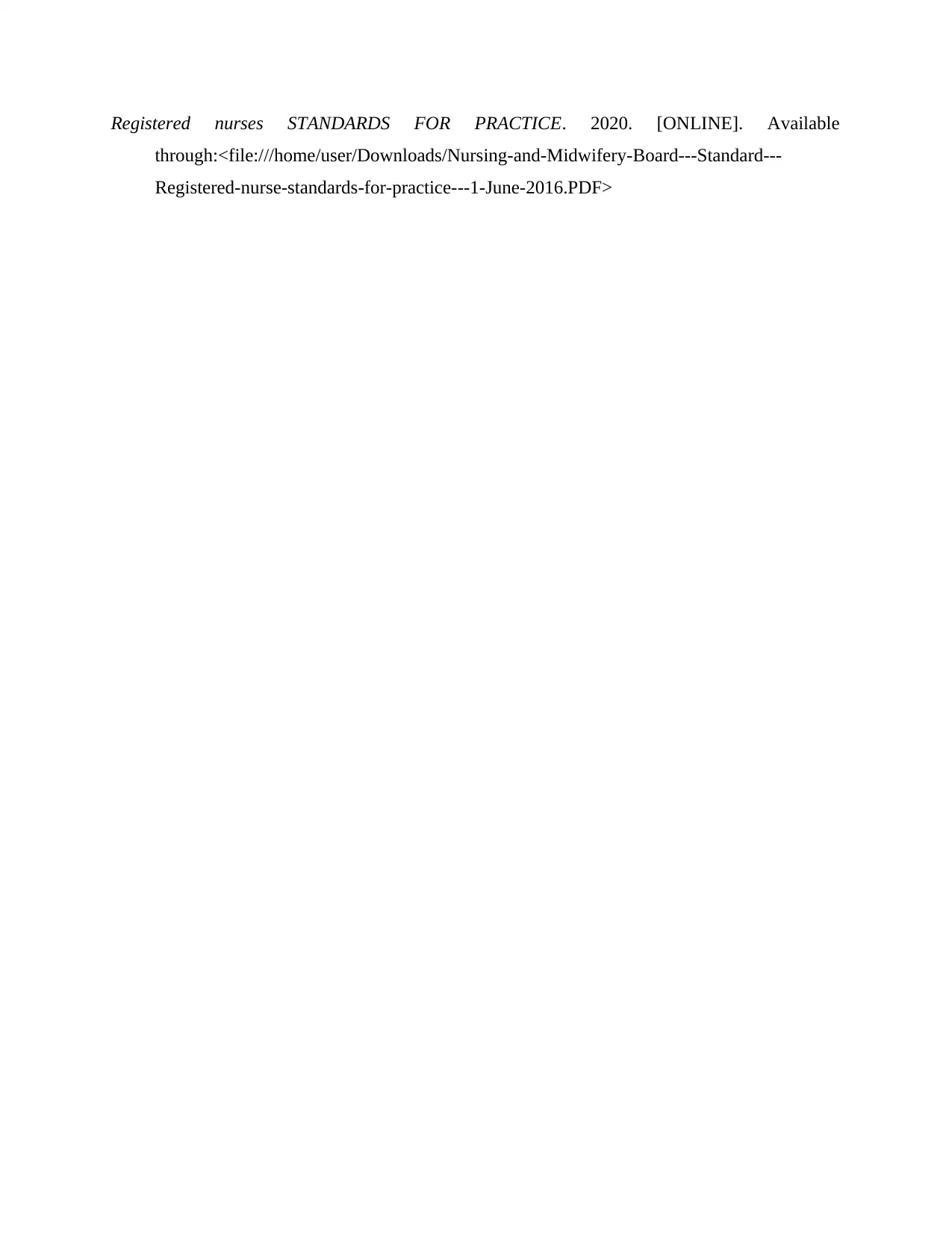
Registered nurses STANDARDS FOR PRACTICE. 2020. [ONLINE]. Available
through:<file:///home/user/Downloads/Nursing-and-Midwifery-Board---Standard---
Registered-nurse-standards-for-practice---1-June-2016.PDF>
through:<file:///home/user/Downloads/Nursing-and-Midwifery-Board---Standard---
Registered-nurse-standards-for-practice---1-June-2016.PDF>
⊘ This is a preview!⊘
Do you want full access?
Subscribe today to unlock all pages.

Trusted by 1+ million students worldwide
1 out of 9
Related Documents
Your All-in-One AI-Powered Toolkit for Academic Success.
+13062052269
info@desklib.com
Available 24*7 on WhatsApp / Email
![[object Object]](/_next/static/media/star-bottom.7253800d.svg)
Unlock your academic potential
Copyright © 2020–2025 A2Z Services. All Rights Reserved. Developed and managed by ZUCOL.




